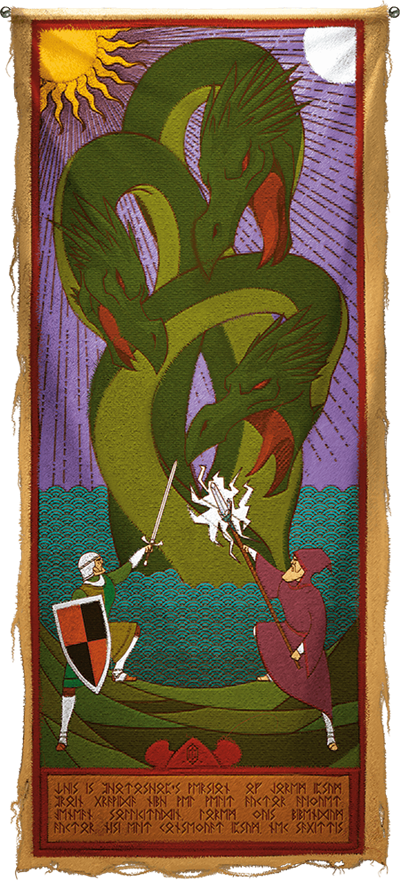 We’ve completed our second full rotation of the twelve classes in the Player’s Handbook, not to mention taken a deep dive into the first 5 levels of D&D’s thirteenth class, the inventive and arcane Artificer! This wave of the Class 101 series will appraise every subclass within the Player’s Handbook and break down each subclass’s strengths, weaknesses, thematic elements, and everything else a player would want to know before playing that subclass. Because of this, you will need to own the Player’s Handbook (or purchase the subclass a la carte on the Marketplace) in order to make full use of this series.
We’ve completed our second full rotation of the twelve classes in the Player’s Handbook, not to mention taken a deep dive into the first 5 levels of D&D’s thirteenth class, the inventive and arcane Artificer! This wave of the Class 101 series will appraise every subclass within the Player’s Handbook and break down each subclass’s strengths, weaknesses, thematic elements, and everything else a player would want to know before playing that subclass. Because of this, you will need to own the Player’s Handbook (or purchase the subclass a la carte on the Marketplace) in order to make full use of this series.
The fighter class is one of the most thematically versatile classes in Dungeons and Dragons. That is to say, while classes like paladin or warlock impose a certain level of roleplaying flavor on your character from the very beginning, a fighter is more or less a blank canvas for your own character’s story. When playing an Eldritch Knight, a type of fighter that uses weapons and destructive spells in conjunction, you’re free to determine how you gained your martial and magical skills, and what you want to achieve with them.
Check out the other guides in the Class 101 series, like the broad overview of the druid class in Fighter 101: A Beginner’s Guide to Heroic Combat, Fighter 101: Champion, and Fighter 101: Battle Master. If you’re interested in playing other classes, check out the entire Class 101 series.
Story of the Eldritch Knight
“What are you doing?” a young brother asked his sister. The sister, a fighter, knelt before a makeshift altar cobbled together by wooden boards atop two sawhorses, draped with a simple burlap cloth. A longsword rested on the altar. Her eyes were closed, and she was dressed in a simple tunic and breeches, her hair pulled into a bun. The suit of armor she had inherited from her father hung on a stand nearby. Her brow twitched with annoyance as her brother spoke.
“I’m meditating,” she grumbled. She let out a long breath and reached out into the aether once more with her consciousness, feeling for the strands of the Weave that were strung invisibly around her. She hovered her open hand over the hilt of sword, and felt new strands of magic forming between the wellspring of magic within her and the sword.
“Can I help?” her brother, bounding to her side, a huge grin on his face. “You meditating with that sword? You gonna do magic? Can I see? Can I see your magic?”
The sister scowled and growled through gritted teeth, “If you can sit still for ten minutes, yes.”
Miraculously, he was. He sat cross-legged next to his kneeling sister, alternating between gawking at the look of calm concentration on her face and the gently humming sword on the homemade dais before her. Ten tense minutes passed, and the fighter’s eyes snapped open. A flash of light glinted upon her irises, and then vanished just as quickly as it appeared. She stood and flexed her trembling hand.
“Okay,” she said to her brother, pointing to the sword. “Take it.”
“Really?” her brother gasped, eyes wide and shining with excitement.
“Yeah, really,” the fighter said, looking away. “Just watch the blade and don’t hurt yourself. Or, if you do hurt yourself, say you were playing in the forest. Mom’ll kill me otherwise.”
“Whoo hoo!” her brother whooped. He picked up the sword and swung it into the air over his head. He ran around the cellar room, slashing at invisible foes and imagining he was just like their father, killing monsters that threatened their village. His sister smiled at his excitement, then focused herself. She focused her eyes upon the hilt of the sword as her brother ran about and steadied her breathing. She tuned out all the distractions of the Material Plane and focused solely upon the strands of the Weave that bound her to the blade. She felt a surge of energy tingle from her chest down her arm, and at the moment the surge passed through her fingertips, the sword vanished from her brother’s hands.
Her brother yelped and looked around. “Ahhh! It’s gone!” he gasped. “I’m so sorry, it just—!” He turned to his sister and his jaw dropped open. Clutched in his sister’s right hand was her father’s sword. Her heart was pounding as she stared at the sword she had just magically conjured to her, but she managed to compose herself and look at her brother with a flicker of smugness.
“See?” she said. “Magic.”
Eldritch Knight Features
Eldritch Knight fighters memorize a number of destructive and protective spells during their training, in addition to other magical abilities that allow them to meld their martial and magical prowess. The fighter gains access to five subclass features at 3rd, 7th, 10th, 15th, and 18th level. You can read all of the Eldritch Knight features in the Player’s Handbook. In summary, your subclass features allow you to:
- You learn two cantrips from the wizard spell list
- You gain the ability to memorize and cast a number of abjuration and evocation spells from the wizard spell list
- You bond with your weapon, allowing you to summon it to your hand at any time
- You can make a weapon attack as a bonus action when you cast a cantrip
- Your weapon attacks make creatures less likely to succeed on saving throws against your spells
- You can teleport short distances when you use your Action Surge feature
- You can make a weapon attack as a bonus action when you cast a spell as an action
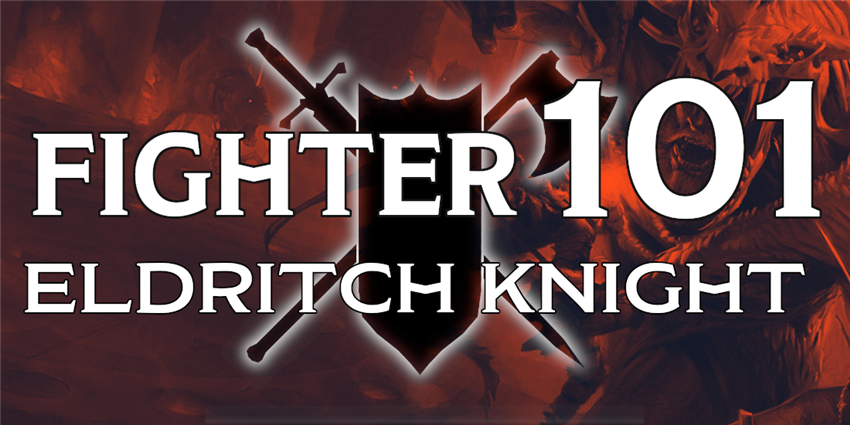
Benefits of the Eldritch Knight
There are a number of different options available for people who want to wield both spells and weapons—what does the Eldritch Knight bring to the table? The paladin offers a “jack of all trades” option by combining heavy armor and spiky damage through Divine Smite, the bardic College of Valor and clerical Light Domain provide spell-heavy options for moderately armored warriors, and the Bladesinger wizard tradition encourage lightly armored warriors to dance into battle, supported by their mighty spells.
Eldritch Knights curve in the opposite direction, using spells to complement their impressive suite of powerful defenses and overwhelming attacks. Typically, fighters can only focus on single targets with their attacks, and struggle against foes whose armor shrugs off these attacks. This encourages a very specific playstyle for Eldritch Knights: focus on spells that target multiple foes (or that effect an area), and find spells that force enemies to make a saving throw instead of requiring you to make an attack roll.
Your spells are situational tools, and the limited number of spell slots you get per day are a stark reminder of this. Don’t forget: you’re still a fighter first. Stay in the thick of combat, bashing helmets and tanking blows until your enemies have all clumped up around you, then let loose a well-timed burning hands to maximum effect. If you want to add a little more variety to your repertoire than evocation (offensive) or abjuration (defensive) spells can offer, you can add a spell from any school of magic to your list of Spells Known at 8th, 14th, and 20th level.
As you gain levels in this class, your class features will help make you more flexible. Generally, you’ll have to choose between making an attack and casting a spell on a given turn. Features like War Magic, Eldritch Strike, and Improved War Magic make this choice much less painful by letting you cast spells and make an attack in the same turn—and even giving you a benefit to doing so against the same foe.
Drawbacks of the Eldritch Knight
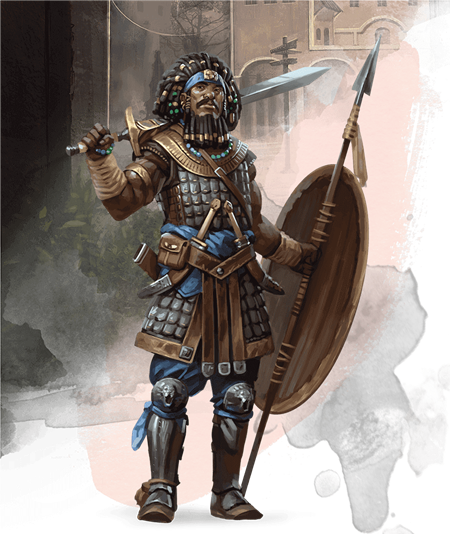 The biggest challenge of playing an Eldritch Knight is a conflict between casting spells and making attacks. These two styles of D&D combat mix like water and oil, and it’s difficult to meld them together in a way that evokes the fluid feelings of magically enhanced martial combat in popular fantasy series like Avatar: The Last Airbender or Star Wars. Casting a spell and making a weapon attack are two discrete actions; unless you’re using a purpose-made cantrip like green-flame blade, you can’t weave magic into a sword strike.
The biggest challenge of playing an Eldritch Knight is a conflict between casting spells and making attacks. These two styles of D&D combat mix like water and oil, and it’s difficult to meld them together in a way that evokes the fluid feelings of magically enhanced martial combat in popular fantasy series like Avatar: The Last Airbender or Star Wars. Casting a spell and making a weapon attack are two discrete actions; unless you’re using a purpose-made cantrip like green-flame blade, you can’t weave magic into a sword strike.
Spells that can be cast as a reaction or a bonus action, like misty step or shield, soften this issue somewhat, allowing you to make an attack and then repel your foes’ strikes with a shimmering barrier of force. Nevertheless, it can be frustrating to have to page through a list of abjuration or evocation spells with a casting time of 1 reaction or 1 bonus action to find what spells will support the character concept you have in your head.
At least that sort of research digitally is much easier than doing so with a print book, thanks to the D&D Beyond Spell tool—which, troublingly, reveal the limits of this restriction: there are only three 1-reaction-casting-time spells that fit those criteria, and no 1-bonus-action-casting-time spells. So, while the Eldritch Knight is a reasonably powerful class, the challenges of melding spellcasting and sword fighting into one fluid motion may frustrate you if you’re looking for a highly cinematic experience in your D&D game.
If you want to be able to cast spells and fight, but you’re playing a low-level one-shot or don’t think your campaign will advance past 6th level, you might be better off playing a Champion fighter and taking Magic Initiate (Wizard) feat, granting you two wizard cantrips and one 1st-level wizard spell that you can once per long rest. Your spellcasting will be much more limited than if you’d chosen to play an Eldritch Knight—at 5th level, an Eldritch Knight knows two cantrips but also knows 4 wizard spells and has three 1st-level spell slots with which to cast them. However, if giving your fighter a little bit of magical flavor is all you want, then Champion’s suite of simple, powerful combat-focused features might be more appealing.
Suggested Build
Like most classes in D&D, the fighter doesn’t choose their subclass until 3rd level. If you’re playing a fighter from 1st level and think you want to become an Eldritch Knight later, you should choose a race that improves your Strength (or Dexterity) score and also your Intelligence score. Strength affects how hard you hit with most melee weapons, whereas Dexterity makes you better with ranged or finesse weapons. Your Intelligence score affects how likely you are to hit with your spell attacks, and how high your spell save DC is, which makes it harder for foes to resist your spells. Because of this, your Strength or Dexterity score should be your highest ability score, and your Intelligence should be your second highest score.
You can play an Eldritch Knight as a heavily armored, greatsword-wielding tank, or as a lithe and nimble, rapier-wielding duelist. If you want to play the former, some good races include half-orc, dragonborn, rock gnome, and mountain dwarf. To play the latter, races like forest gnome and high elf will do the trick. Humans and half-elves are well-suited to just about any class, as well.
As usual, your character’s background is up to you. You can come up with all sorts of interesting stories and oddball characters by pairing unlikely backgrounds with the Eldritch Knight’s particular blend of sagely study and rough-edged athleticism. Were you a Sage who abandoned a rigorous regimen of “useless” magical study to practice destructive arts instead? Or were you a Noble whose tutors encouraged you to dabble in many different forms of martial artistry?
It’s a safe bet to choose EQUIPMENT when given the choice between GOLD or EQUIPMENT during character creation. The various types of equipment available to fighters easily suits either a Strength or Dexterity-focused playstyle. Choose chain mail and a martial weapon plus a shield if you want to focus on Strength, and choose leather armor, a longbow, and a rapier if you want to focus on Dexterity. Since you will gain class features that allow you to make weapon attacks as a bonus action when you cast a spell, you should focus on wielding a shield and a rapier if you want to be a Dexterity-based fighter, rather than dual wielding light weapons.
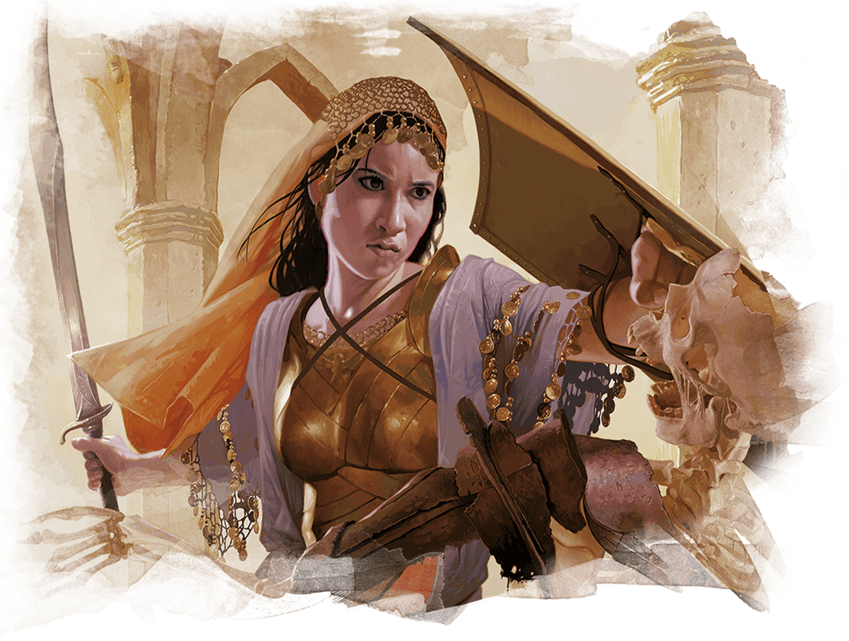
Spells
You gain the ability to cast spells when you choose this subclass at 3rd level. Your spell selection is quite limited—not only do you memorize spells instead of being able to prepare them at the start of a day, but you only have a scant two 1st-level spell slots to use. While this number increases as you level up, it encourages you to reserve your spells for big, flashy moments of destruction, or in desperate last-ditch efforts.
As a 3rd-level Eldritch Knight fighter, you know two cantrips from the wizard spell list. Since you’re likely to be in melee combat, it’s good to choose one offensive cantrip with a range of at least 60 feet to extend your reach. Your second cantrip should be either a utility cantrip to help round out your character’s skill set, or an offensive cantrip with a range of 5 feet, so that you don’t have to worry about having disadvantage when making a ranged attack while in close combat.
Also at 3rd-level, you know three spells: two 1st-level abjuration or evocation spells from the wizard spell list, and one 1st-level spell of any school from the wizard spell list. Choose these spells wisely; though you can trade out one spell you know for another when you gain a level in this class, these spells are otherwise permanent decisions. It’s wise to know at least one spell labeled OFFENSE and one labeled DEFENSE, and choose your third spell based on what you think your character would want to know. Note that this list only includes some spells from the Player's Handbook, so if you want to choose more unusual spells, or have other sources like Xanathar's Guide to Everything, you'll have to do a little self-directed research. This list is just here to get you started if this is your first time playing an Eldritch Knight.
- Alarm (SUPPORT)
- Burning hands (OFFENSE)
- Chromatic orb (OFFENSE) [be aware that you’ll have to purchase a diamond worth 50 gp in order to cast this powerful spell!]
- Magic missile (OFFENSE)
- Protection from evil and good (DEFENSE)
- Shield (DEFENSE)
- Thunderwave (OFFENSE)
Feats
As a fighter, you gain two more Ability Score Increases than any other class in the game. (The extras come at 6th and 14th level.) This means that it’s incredibly easy for you to take one or even two feats while still maxing out your vital ability scores!
Once you’ve improved your Strength or Dexterity score to 18 or 20, you can increase your power with a few useful feats. The following feats are good picks for Eldritch Knight fighters, and will improve your reliability in your own desired area of expertise:
Great Weapon Master. These days, it practically goes without saying that Great Weapon Master is one of the best feats in the game. Choosing this feat will send your damage output into the stratosphere, though only if you’re using a two-handed weapon.
Polearm Master. This feat synergizes well with War Caster and Sentinel, making it difficult for enemies to approach you or maneuver around you.
Sentinel. A must-have feat for any fighter interested in tanking for their party, Sentinel makes it hard for enemies to attack your allies, or for them to leave your reach once they’ve approached you.
Shield Master. A specialized but useful choice for Eldritch Knights who want to wield a shield rather than go for a two-handed weapon. An excellent choice for Dexterity-focused fighters wielding a rapier and a shield.
War Caster. Eldritch Knights, especially those who wield a one-handed weapon and a shield, can make use of every aspect of this feat. Making it easier to maintain concentration while taking damage is always a benefit, and not having to have a hand free to perform a spell’s somatic components is a huge boon when you can't afford to drop your shield or your rapier. Gaining the ability to make opportunity attacks with your spells is also excellent! Just imagine hurling a guaranteed-to-hit magic missile at a fleeing foe.
If you want more advice for building a fighter, check out Fighter 101. Have you ever played an Eldritch Knight fighter? What advice would you give to players that want to play this subclass? Next week, Class 101 will cover the monk's Way of Shadows archetype, an unseen ascetic who strikes from the shadows. What's your fighter character like? Let us know in the comments!
Create A Brand-New Adventurer Acquire New Powers and Adventures Browse All Your D&D Content
 James Haeck is the lead writer for D&D Beyond, the co-author of Waterdeep: Dragon Heist, Baldur's Gate: Descent into Avernus, and the Critical Role Explorer's Guide to Wildemount, a member of the Guild Adepts, and a freelance writer for Wizards of the Coast, the D&D Adventurers League, and other RPG companies. He lives in Seattle, Washington with his fiancée Hannah and their animal companions Mei and Marzipan. You can find him wasting time on Twitter at @jamesjhaeck.
James Haeck is the lead writer for D&D Beyond, the co-author of Waterdeep: Dragon Heist, Baldur's Gate: Descent into Avernus, and the Critical Role Explorer's Guide to Wildemount, a member of the Guild Adepts, and a freelance writer for Wizards of the Coast, the D&D Adventurers League, and other RPG companies. He lives in Seattle, Washington with his fiancée Hannah and their animal companions Mei and Marzipan. You can find him wasting time on Twitter at @jamesjhaeck.








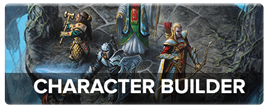
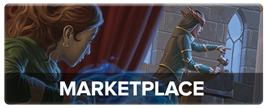
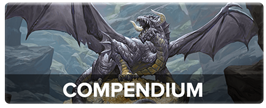
-
View User Profile
-
Send Message
Posted Nov 19, 2020Why a pair of handcrossbows? How do they reload?
-
View User Profile
-
Send Message
Posted Nov 19, 2020Crossbow expert ignore the loading property of crossbows because they are so skilled and fluent with them it's a seamless transition
-
View User Profile
-
Send Message
Posted Nov 19, 2020You still need a free hand to reload, all Crossbow Expert does is let you make more than one attack per round provided you've got the ammo.
-
View User Profile
-
Send Message
Posted Nov 19, 2020The additional attack via a Bonus Action isn't, in any way, associated with two weapon fighting. That requires a melee attack with the attack action. The bonus action attack with the hand crossbow is because you're rapidly reloading. Not unlike a pistoleer fanning the hammer of their revolver.
-
View User Profile
-
Send Message
Posted Nov 19, 2020Not according to how the feat reads. For thematic purpose Roland juggles ebony and ivory while turning enemies into pincushions
-
View User Profile
-
Send Message
Posted Nov 19, 2020The feat doesn't say anything about needing a free hand to reload because that's the base rule and the feat isn't changing it. Also, dual-wielding hand crossbows with Crossbow Expert is redundant anyway because you need a bonus action to make an attack with your second weapon while using two-weapon fighting, and you also need a bonus action to make an extra attack with a hand crossbow from Crossbow Expert. Since you only get one one bonus action per round, you can't stack the effects.
-
View User Profile
-
Send Message
Posted Nov 19, 2020The feat was mainly for getting rid of disadvantage and loading property.
-
View User Profile
-
Send Message
Posted Nov 19, 2020That's all fine and good, but you also have to remember what it cannot do. There's no ignoring the ammunition property and the need to reload after each shot. As it stands, you only need one hand crossbow. You can either attack with it, and again as a bonus action, or you can attack with a melee weapon and shoot as a bonus action. And even then you don't have a free hand to reload.
Dual wielding doesn't work if you're making multiple attacks with Extra Attack. It's just not possible.
-
View User Profile
-
Send Message
Posted Nov 23, 2020If you are A Dragonmarked EK, Are you able to choose the Mark Spells at any point even if they aren't and abjuration or evocation wizard spell?
Are they added to the overall Wizard spell list or the Eldritch Knight Spell List?
Anyone Know?
-
View User Profile
-
Send Message
Posted Nov 23, 2020The wording for dragonmarks says the spells are "added to the spell list of your spellcasting class."
The wording on Eldritch Knight is "You know three 1st-level wizard spells of your choice, two of which you must choose from the abjuration and evocation spells on the wizard spell list."
I don't know of any "sage advice" clarifications, and of course your DM can rule how they wish; but with that wording, it's a stretch to interpret this as giving your Eldritch Knight the ability to ignore the restriction and choose any spell associated with the mark. They could use their unrestricted choice to take any spell associated with the dragonmark, but the two restricted choices could only be abjuration/evocation spells (from the dragonmark or the general wizard list).
But if you're looking to munchkin up, the Mark of Healing gives you a bunch of evocation healing spells a fighter could otherwise not easily get (and the ability to cast them with INT instead of needing a good WIS too) that will keep you tanking. In fact, every spell on that list is unrestricted for you!
-
View User Profile
-
Send Message
Posted Nov 24, 2020Being Dragonmarked expands the list of available spells for anyone of that race who is a spellcaster. So yes, they ought to count as valid spells for an Eldritch Knight to learn.
-
View User Profile
-
Send Message
Posted Nov 24, 2020Sounds About Right.
Thanks Guys
-
View User Profile
-
Send Message
Posted Nov 24, 2020Dragonmarks, among other things, add spells to your spellcasting class' spell list. Eldritch Knights use the wizard spell list, so any mark spells not already on that list get added. But the EK is still bound by the restrictions of their spellcasting feature. Still, you may now have new options for those spells known.
-
View User Profile
-
Send Message
Posted Nov 25, 2020Technically, the crossbow feat doesn't allow you to dual-wield hand crossbows; you still need a free hand because of the ammunition property. But since the feat does allow you to make the same number of attacks with a single hand crossbow as if you were theoretically dual-wielding two hand crossbows, I say the "rule of cool" applies, and a DM should allow the player to dual-wield a pair of hand crossbows if they so desire.
-
View User Profile
-
Send Message
Posted Dec 13, 2020Which is why the bonded weapon should act as an arcane focus (as Bard college of Swords does). Requiring a feat tax to cast, no shield use viable, an interacting with object limitations regarding drawing/sheathing weapons demands homebrew to make this subclass function.
Luckily my DM interpreted the subclass RAI, not RAW.
-
View User Profile
-
Send Message
Posted Dec 14, 2020To be fair I think most dms would be fine with letting your character just cast their spells, or at the very least, allow you to equip a special shield that is affixed to your arm and allows free use of items, similar to the sword and shield weapon from Monster Hunter for example, which is the only weapon that allows you to grab items from your bag while it is unsheathed since the shield is essentially tied to your forearm.
-
View User Profile
-
Send Message
Posted Dec 14, 2020Weapon bond is intended to address this. You drop your weapon, and even with a shield in the other hand, you have a free hand to cast. It then requires only a bonus action to retrieve your weapon, allowing you to attack with it again on your next turn.
Yes, you do burn that bonus action, but you're still able to switch between melee and ranged at a lower cost than most classes.
It's probably not game-breaking to allow you to use the bonded weapon as a focus, but it is nice. It makes two-weapon fighting a better idea, and you don't have to worry as much about when to use your Second Wind.
-
View User Profile
-
Send Message
Posted Jan 9, 2021"The biggest challenge of playing an Eldritch Knight is a conflict between casting spells and making attacks. These two styles of D&D combat mix like water and oil, and it’s difficult to meld them together in a way that evokes the fluid feelings of magically enhanced martial combat in popular fantasy series like Avatar: The Last Airbender or Star Wars."
In other words, it's a class that fails to replicate the iconic character archetypes people want to try and play with it.
-
View User Profile
-
Send Message
Posted Jan 9, 2021It's a bit of a strange criticism to make; neither benders or Jedi really fit an Eldritch Knight, as neither are armoured fighters. Both are arguably better represented by a Way of the Four Elements Monk, though that sub-class is not without its own problems (limited flexibility, and most of its spells cost too many Ki points to use), or a Monk multi-class (maybe War Domain Cleric for a Jedi, Tempest Cleric or Druid for a bender?).
Eldritch Knights are knights (as in plate-clad fighters) first, casters second; your action should be used to attack most of the time, except when you can use a cantrip and bonus action attack instead (which works great with Booming Blade or Green-Flame Blade once they level up). The only action spells you should be taking are maybe ranged (I like Magic Missile as an option for the auto-hitting, rarely resisted damage) or utility spells for out of combat options. Otherwise for combat you want reaction spells like Shield or Absorb Elements to give your fighter's already solid defence the option of a further boost when you really need it.
-
View User Profile
-
Send Message
Posted Feb 20, 2021Looking at Tasha's, and Blind Fighting fighting style, thinking Darkness will work well as a spell.